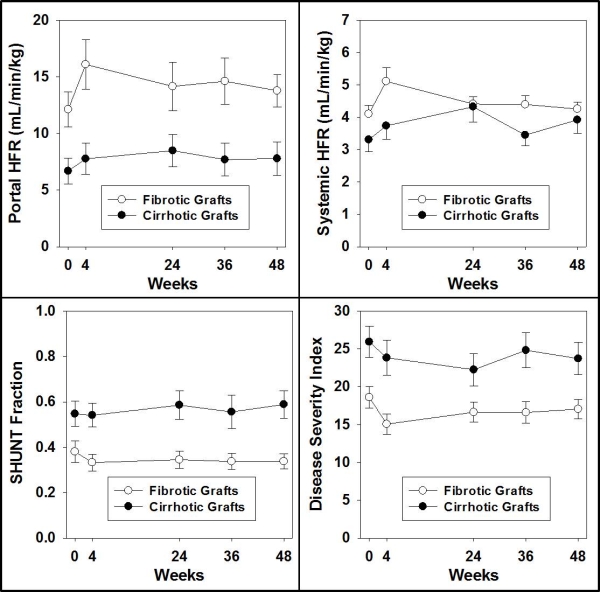Time Course of Hepatic Graft Function Improvement After Ledipasivir/Sofosbuvir Treatment in Liver Transplant Recipients with HCV and Fibrosis or Cirrhosis Who Achieved SVR.
S. Helmke,1 J. O'Leary,2 J. Burton,1 M. Cookson,1 S. Lauriski,1 J. Trotter,2 J. McHutchison,3 G. Everson.1
1University of Colorado, Aurora, CO
2Baylor University Medical Center, Dallas, TX
3Gilead Sciences, Inc., Foster City, CA.
Meeting: 2016 American Transplant Congress
Abstract number: 266
Keywords: Hepatitis C, Liver cirrhosis, Liver grafts, Non-invasive diagnosis
Session Information
Session Name: Concurrent Session: Viral Hepatitis
Session Type: Concurrent Session
Date: Monday, June 13, 2016
Session Time: 2:30pm-4:00pm
 Presentation Time: 3:18pm-3:30pm
Presentation Time: 3:18pm-3:30pm
Location: Ballroom A
Background: In SOLAR-1, liver transplant recipients with HCV and either fibrosis or cirrhosis were treated at baseline with ledipasvir/sofosbuvir and ribavirin for 12 or 24 weeks and assessed for SVR after another 24 weeks. In the HepQuant substudy, the improvement of graft function was evaluated over time.
Liver Transplant Recipients: 21 recipients participated in the substudy, 10 with F0-F3 fibrosis (5 at CU, 5 at BUMC), and 11 with cirrhosis (5 at CU, 6 at BUMC) (3 CTP A, 6 CTP B, 2 CTP C). All, except 1 CTP C recipient, achieved SVR.
HepQuant®-SHUNT Test: Recipients were tested at baseline and at 4, 24, 36, and 48 weeks. Serum samples were taken prior to, and at 5, 20, 45, 60, and 90 minutes after administration of stable isotope labeled cholates, to yield Portal Hepatic Filtration Rate (HFR) from PO d4-cholate, Systemic HFR from IV 13C-cholate, SHUNT from the ratio of Systemic to Portal HFR, and disease severity index (DSI) from these 3 test results.
 Results: At baseline, the HFRs were higher, and SHUNT and DSI were lower in fibrotic recipients than in cirrhotic recipients. The HFRs and DSI reached maximum improvement at 4 weeks in fibrotic recipients and at 24 weeks in cirrhotic recipients. SHUNT did not change significantly. The Systemic HFR in cirrhotic recipients improved to nearly that of the fibrotic recipients at 24 and 48 weeks. Both cirrhotic and fibrotic recipients had an 8% reduction in DSI at 48 weeks, while the functional improvement was mainly in the Systemic HFR in cirrhotic recipients and in Portal HFR in fibrotic recipients.
Results: At baseline, the HFRs were higher, and SHUNT and DSI were lower in fibrotic recipients than in cirrhotic recipients. The HFRs and DSI reached maximum improvement at 4 weeks in fibrotic recipients and at 24 weeks in cirrhotic recipients. SHUNT did not change significantly. The Systemic HFR in cirrhotic recipients improved to nearly that of the fibrotic recipients at 24 and 48 weeks. Both cirrhotic and fibrotic recipients had an 8% reduction in DSI at 48 weeks, while the functional improvement was mainly in the Systemic HFR in cirrhotic recipients and in Portal HFR in fibrotic recipients.
Conclusions: Functional improvement in cirrhotic recipients is slower than in fibrotic recipients. The cirrhotic recipients achieved a Systemic HFR almost equivalent to fibrotic recipients. HepQuant®-SHUNT testing revealed differences between fibrotic and cirrhotic grafts in the time course and the mechanistic features of functional improvement.
CITATION INFORMATION: Helmke S, O'Leary J, Burton J, Cookson M, Lauriski S, Trotter J, McHutchison J, Everson G. Time Course of Hepatic Graft Function Improvement After Ledipasivir/Sofosbuvir Treatment in Liver Transplant Recipients with HCV and Fibrosis or Cirrhosis Who Achieved SVR. Am J Transplant. 2016;16 (suppl 3).
To cite this abstract in AMA style:
Helmke S, O'Leary J, Burton J, Cookson M, Lauriski S, Trotter J, McHutchison J, Everson G. Time Course of Hepatic Graft Function Improvement After Ledipasivir/Sofosbuvir Treatment in Liver Transplant Recipients with HCV and Fibrosis or Cirrhosis Who Achieved SVR. [abstract]. Am J Transplant. 2016; 16 (suppl 3). https://atcmeetingabstracts.com/abstract/time-course-of-hepatic-graft-function-improvement-after-ledipasivirsofosbuvir-treatment-in-liver-transplant-recipients-with-hcv-and-fibrosis-or-cirrhosis-who-achieved-svr/. Accessed December 16, 2025.« Back to 2016 American Transplant Congress
